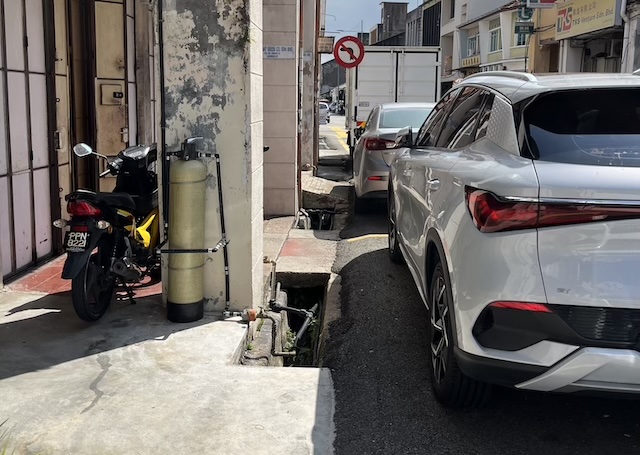Malaysia
Noah Caldwell-Gervais distinguishes a vacation, where the goal is consistent pleasure, from an adventure, which aims for strong peaks and valleys of experience. My goal in visiting Malaysia was adventure; I recommend it accordingly.
Kuala Lumpur
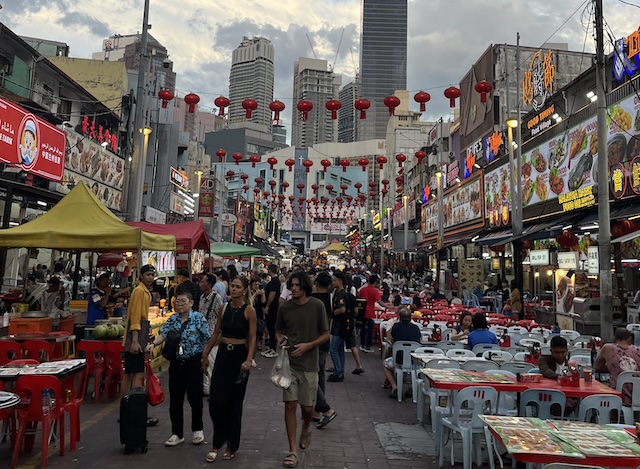
More than anywhere I've been, even China, Kuala Lumpur feels mid metamorphosis. On one block, shiny subways shepherd crowds of people to pristine skyscrapers' luxury malls (there were three Gucci stores within a mile of our hotel, three Prada stores, three Louis Vuittons, &c.) One block away, the sidewalks are crumbling. Stray cats hunt mice in the shadows of rotting brutalist buildings consumed by trees. Within living memory, this city was poor, but it is rapidly becoming rich. For now, things are gritty or sterile, with no middle ground (though the gritty streets hold countless hidden gems, and never feel unsafe). Accordingly, the prices make no sense; a Grab (read: Uber) across town is $5, meals can be anywhere from $2 to $60, a coconut is $1.50 while a durian is $25, and a Gin and Tonic at our hotel bar cost 30% as much as the room.
The key word for this city is "vibrant". While not as diverse as, say, Hong Kong, the city's a melting pot. We visited mosques, Hindu, Buddhist, and Taoist temples, and a Gurdwara. Chinatown's the tourist draw, but my favorite neighborhood is Brickfields, the city's Little India, which overwhelms with color and sound. There are endless night markets, some permanent and some pop-ups for Ramadan. Food streets host a hundred restaurants, each with menus 30 pages long, all fighting for your patronage like car salesmen. Between the high Muslim population and exorbitant alcohol tax, drinking is only a small part of the nightlife, but the delicious food and energetic crowds are themselves intoxicating.
The Muslim majority leads to some delightful culture shock (restaurants adapt pork dishes to use "beef bacon" and "chicken ham"), but it never felt conservative or stifling. Hijabs are a common sight, but most women don't wear them, and I saw fewer burqas than I would in Seattle. Nobody bats an eye at women in tank tops. Most mosques are austere, so they're not as enticing for tourists as churches in Europe, or the Hindu and Buddhist temples scattered here, but it was always a joy to hear the call to prayer.
I'll miss the city's nightlife, but not its urban fabric. The shiny new developments are car-centric; buildings sit on eight-story parking podiums feeding four lane arterials, and pedestrians are funneled through hermetically-sealed skybridges so we don't interfere. The subway is neat and efficient, but transfers might require you walk through a mall. Crossing the street's an adventure. The city's a maze. There's minimal green space: an overly manicured park by the Petronas towers is better admired from above than within, most of the other greenery is golf courses and cemeteries, and the "botanical garden" that looks so lush on a map is really a car-centric pipeline between disconnected pods: a bird park, sculpture garden, &c. I'm spoiled by the Pacific Northwest. Our cities integrate with the forest, and we embrace the radical idea that someone could walk there.
I will happily return to Kuala Lumpur, and when I do it will be a different city. I just hope it doesn't turn into Dubai.
Ipoh
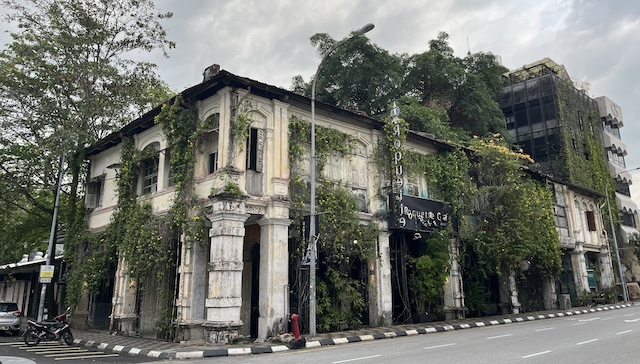
Ipoh wasn't a planned destination, but an impromptu stop when our intended train to George Town was overbooked. This city is also in transition, but its rebirth is embryonic. Ipoh used to be a tin mining town, and you can see the ruins of the luxurious buildings for bosses and the tenement housing for miners themselves. Today, everything's in disrepair, and some streets feel post-apocalyptic. Walking empty streets past shuttered buildings feels unsettling; the grittiest parts of Kuala Lumpur never did.
Ipoh is trying to rebuild, and there are green shoots. Some buildings have been lovingly restored. There's creative street art and beautiful gentrified restaurants for trendy visitors who, on our day out, barely came. We stayed in a brand new hotel, surrounded by nothing. It's easy to see Ipoh finding new life like Detroit, but it still has a long way to go. Right now, the stop is inessential, and I can't recommend staying more than one night. Visiting still feels like dissecting a corpse.
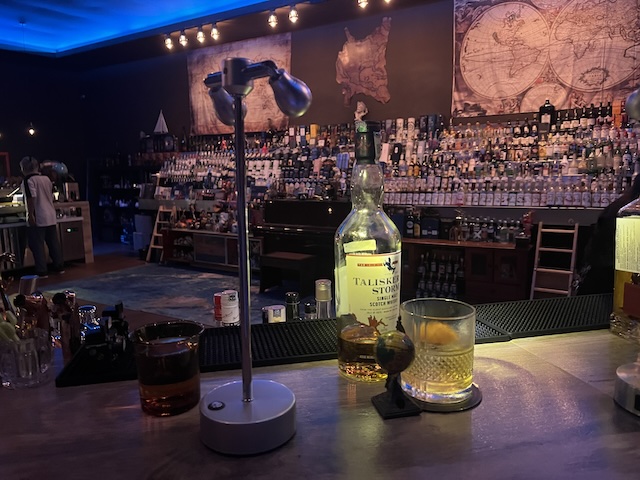
That said, I must celebrate the high point of Ipoh. The Tipsy Bar may be the best value for money bar on Earth. Our host, a flamboyant Hong Kong expat, made mind-blowing improvised drinks with theatrical flair in a breathtaking map-covered room with a war chest of liquor. His superb Ardbeg Wee Beastie Old Fashioned, garnished with Jack Daniel's Honey, Courvoisier, and absinthe(!), was half the price of a Gin and Tonic at our hotel. The drinks were presented with props. We got free samples of other drinks and snacks. At one point, he performed close-up magic. He could charge $40 per drink in LA, but somehow found himself instead in a half-dead town in a Muslim majority country, where his talent is sadly unappreciated. We were his only patrons for an hour, and when another group eventually came in, they seemed less than impressed by his theatrics. For us, this bar justified our detour. If you ever pass through Ipoh, check it out.
George Town
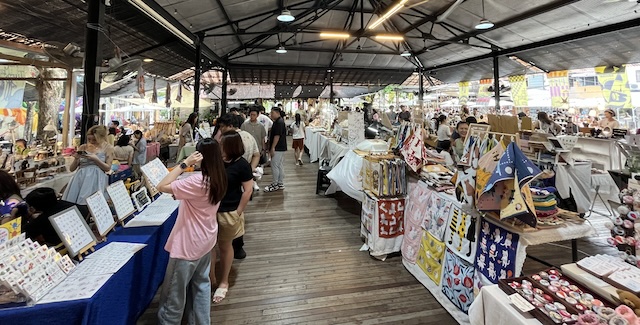
George Town is Malaysia's second biggest city, built around a UNESCO world heritage site. The city strikes the right balance between growth and preservation: the colonial core is suspended in amber, brightened with street art, then surrounding by towering condos and hotels. It offers the amenities of a modern city, the quaint old-time feel of historic streets, and a mix of authentic culture with cute Instagram-able tourist spots, all on a tropical island.
You can experience the city as a hipster, trying sourdough croissants, pitch-black activated charcoal ice cream, vegan ramen, lapsang souchong lychee floats… Everywhere you turn there's cool street art, including ironwork cartoons with metal dialog. I found a pop-up craft market with a live band playing Pulp Fiction's soundtrack, and felt transported to Silver Lake or Williamsburg or Berlin. We found a combination optometrist and ice cream shop, where the ice cream spoons had small eyeglasses (this felt almost satirical, like a parody of those hip barbershops that serve scotch). But if gentrification makes you roll your eyes, it's equally easy to find street food markets without a white face in sight, mix and match a dozen local cuisines, then finish with Cendol (a snow-cone soup with red beans and rice-flour "jelly") for dessert.
This is almost an A+ destination, the most slam dunk travel recommendation you could make. It's jam packed with tourists who've realized its charms. Unfortunately, the city has one fatal flaw: it's the least pedestrian friendly place I've ever been. I've walked large swathes of LA, including the eight mile trek from Silver Lake to Beverly Hills, and enjoyed it. I found walking in George Town intolerable.
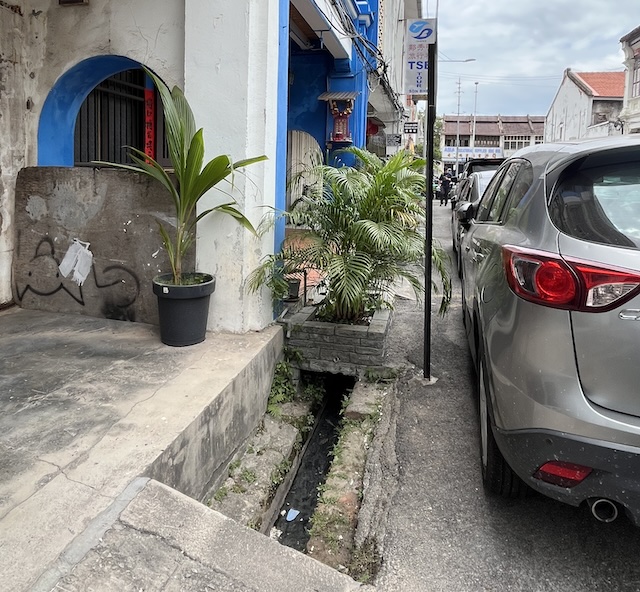
These sidewalks don't have pitfalls, they are pitfalls, with more holes than walkway. The fragments that do exist change height every few feet, then end abruptly with walls or motorbike parking. When the sidewalks prove impassable, you squeeze through a barricade of parked cars, dodge haphazard lampposts and signs, then step onto busy death-trap streets. Like any Urbanist, I've called American cities "hostile". But this? This is hostile. Maneuvering these streets feels like bouldering, and the 90 degree humidity doesn't help. I can't imagine walking here with a disability or heavy luggage; even the blister on my toe felt debilitating. This city has money and thrives on tourism, so I'm baffled by this state of affairs. Is it a woefully misguided form of preservation? When the British were here, they could walk.
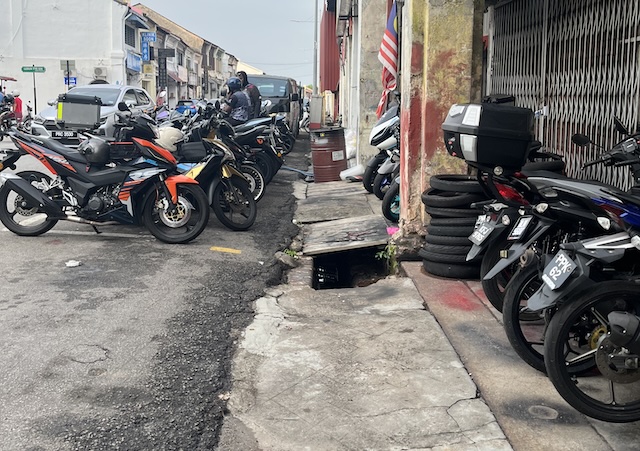
A motivated city could solve this in months. Fill in the sidewalks in the core. Ban motorcycles from parking on them and ticket aggressively. Remove the street parking, or at least paint a buffer zone for humans. Lower the speed limits on the narrowest streets to 5 mph, so people can walk alongside cars as in Japan. Pay for this by doubling the hotel tax; the tourists will be overjoyed.
Until then, while I loved so much about George Town, I wouldn't go back. I don't think the city wants me to return; its sidewalks felt like bared teeth, warning me away.
